30 May 2017
By portermathewsblog
via reiwa.com.au
 The Western Australian State Cabinet decision to move forward with the strata title reform process has been commended by the Real Estate Institute of Western Australia, Strata Community Association WA, Property Council of Australia and Urban Development Institute of Australia WA.
The Western Australian State Cabinet decision to move forward with the strata title reform process has been commended by the Real Estate Institute of Western Australia, Strata Community Association WA, Property Council of Australia and Urban Development Institute of Australia WA.
Announced this morning, the Honorable Rita Saffioti MLA said strata title reform was important to the future housing needs of WA and the McGowan Government would be progressing with this legislation as quickly as possible.
The proposed reforms to the Strata Act, which were drafted by Landgate, cover off seven key areas:
- Community title schemes
- Leasehold strata
- More flexible staged strata development
- Improved management
- Simplified dispute resolution
- Better buyer information
- Safeguards for the termination of schemes
REIWA President Hayden Groves said reform to the Strata Titles Act was long overdue and he was pleased the new State Cabinet would be implementing these reforms.
“REIWA is committed to the strata title reform process, and we are particularly supportive of more buyer information being disclosed and making sure buyers know what they are getting into,” Mr Groves said.
Strata Community Association President Scott Bellerby said the drafted reforms are desperately needed and would help provide more flexible and sustainable housing options.
“The current reforms are a good first step to helping define the role of the strata manager and will provide improved management of schemes, however, further regulation and licensing is still needed.
The Minister should commit to the formation of a working group after the current reforms are passed, to deliver a licensing platform for the State Government to adopt early next year,” Mr Bellerby said.
Property Council Executive Director Lino Iacomella said the introduction of community titles in particular will make a real difference by encouraging more mixed use development in and around activity centres and retirement villages, offering greater amenity to residents and more sustainable local economies.
“These reforms will also provide better outcomes for communities, improving housing choice and affordability for all West Australians,” Mr Iacomella said.
UDIA WA CEO Allison Hailes said The Urban Development Institute of Australia strongly supports the proposed reforms to the Stata Title’s Act, particularly the introduction of community title schemes, leasehold strata and staged strata development.
“The reforms will bring Western Australia’s strata titles legislation in to line with other Australian jurisdictions and result in more affordable and diverse housing being delivered. UDIA encourages all decision makers to support the passage of the new legislation through Parliament as a matter of priority,” Ms Hailles said.
The property industry congratulates Landgate and the McGowan Government for taking a leadership position on such a vital component of the future of WA property.
Comments (0)
30 May 2017
By portermathewsblog
Modiefied via houzz.com.au
Embrace the new season by making your home a cosy and comforting retreat you won’t want to leave.
There are plenty of things to love about winter – soft, woolly blankets, hearty vegie soup and cosy, candlelit nights in, just to name a few. Consider these simple ways to prepare your home for the cooler months ahead and you will love it even more.
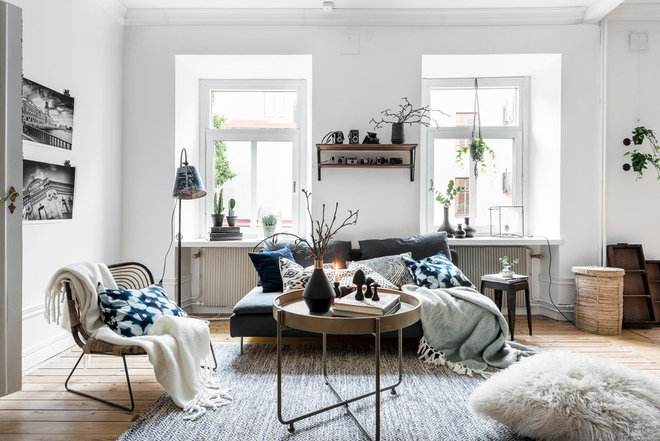 INTRO INRED
INTRO INRED
1. Get your heating sorted
While lots of Australians mightn’t give home heating a second thought for most of the year, now is the time to make sure everything is in good working order. No heater, air conditioning or fireplace? Consider insulation options and ensure you have adequate bedding and blankets on hand for when the temperature drops.
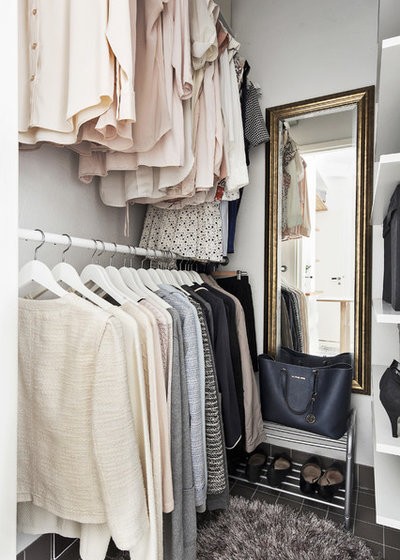
Stylingbolaget
2. Reorganise your wardrobe
Bringing your knits, scarves and boots out of storage can feel like you have a whole new wardrobe! After gently washing woolies, bring cold weather items to the front of the your cupboard and create more room by packing away those you won’t be needing as often, such as swimwear, tank tops and summer dresses.
 Havven
Havven
3. Plan a big night in
There’s no better time of year to organise a weekly night in, and we’re not talking about an evening in front of the television. Cold weather outside is no excuse for being anti-social – stock up on board games and snacks and invite friends over for a weekly get-together, taking it in turns to host.
4. Up your soft furnishings
Early starts are not much fun when it’s freezing above the blankets, so having something soft and warm underfoot can make all the difference. Adding luxe furnishings such as wool, faux fur and velvet to your bedroom and living area brings an instant feeling of cosiness and makes cool mornings more bearable.
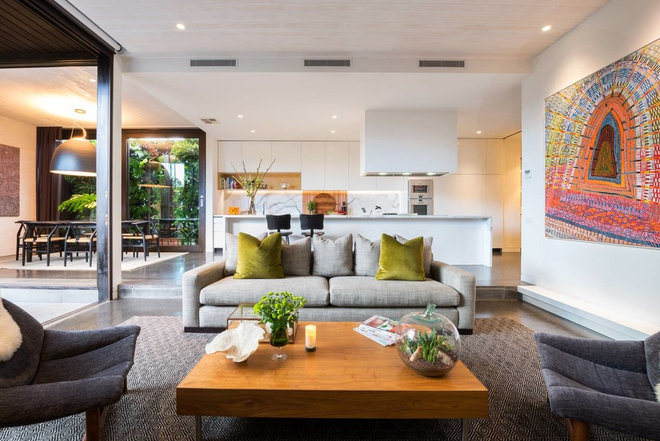 Rachel Lewis Photography
Rachel Lewis Photography
5. Don’t forget about colour
It’s easy to gravitate towards dark, comforting shades when the weather turns icy, but adding some bursts of colour can be a great mood-booster. Bring in some cushions in your favourite hue or hang a vibrant artwork to warm a cool palette.
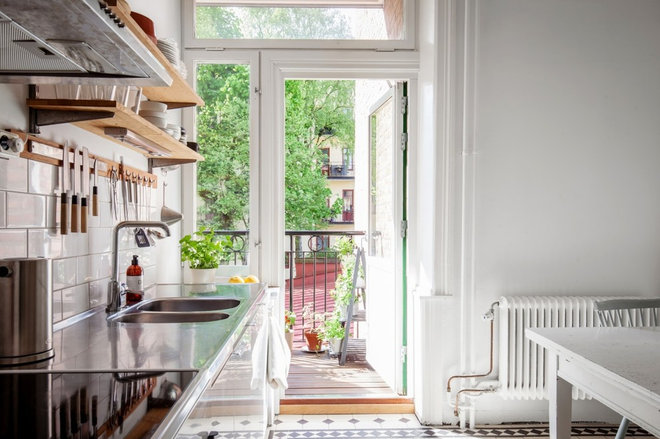 Ahre Fastighetsbyrå
Ahre Fastighetsbyrå
6. Let in some fresh air
Just because things are chilly outside doesn’t mean you need to close the house up. Adequate ventilation is important year-round, and over winter it can be uplifting to throw open the windows and allow some cool, crisp air to freshen up a musty space, even if it’s only for 20 minutes.
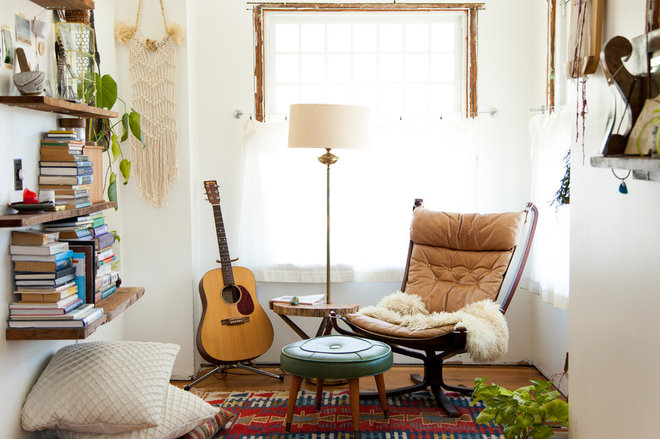 Ellie Lillstrom Photography
Ellie Lillstrom Photography
7. Take up a hobby
With early sunsets and long, cold nights, winter is the ideal time to begin a new project or hobby. Have you always wanted to play the guitar? Take up knitting? Learn a new language? Start now and you’ll be up-skilled by the time spring rolls around.
8. Cook up seasonal produce
Celebrate winter by making a delicious meal with a fresh, seasonal bounty of vegetables. In Australia, beetroot, broccoli, cauliflower, sweet potato and onions are all at their best for whipping up a warming soup.
9. Declutter and refresh
While an annual spring clean is common practice, many might not consider a home refresh and declutter coming into the colder months. Take stock of what’s in your home – do you have adequate storage? Is your living area suitable for indoor entertaining? Is there anything that can be packed away or donated to charity? A winter clean-out can be just as effective as a spring clean in making your home feel fresh and ready for the arrival of a new season.
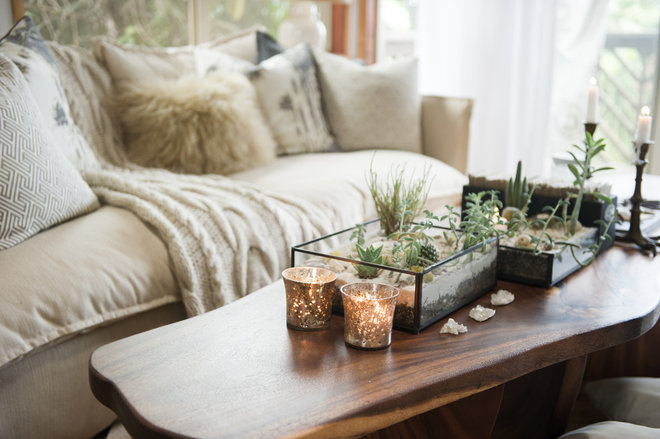 Ashley Camper Photography
Ashley Camper Photography
10. Light a warming candle
Candles are synonymous with winter and add a comforting glow to any dinner setting or bedside table. Look for beeswax and soy candles with natural cotton wicks and pure essential oil fragrances – vanilla, sandalwood and white musk are warming winter fragrances.
Comments (0)
25 May 2017
By portermathewsblog
via domain.com.au
The bathroom is one of the most expensive rooms to remodel. So if you’re on a budget, a bathroom renovation might be out of reach. The good news is you don’t have to live with the ugly – all you need is a little DIY elbow grease.
Try these easy projects to give your bathroom an upgrade, and the best part is, you can do any of these in one weekend.
Update the vanity
 Transform the vanity with new paint and hardware. Photo: Jason Frank Rothenberg / Domino
Transform the vanity with new paint and hardware. Photo: Jason Frank Rothenberg / Domino
Painting the vanity is one of the cheapest ways to upgrade your bathroom and still make a big impact. Sand your existing vanity, and patch any imperfections with wood putty. Then, start with a good oil-based bonding primer before applying the final coats of paint. Finish the look with new hardware
Upgrade the toilet lever
Photo: The Makerista
Something as small as the flusher handle can make a big difference. Upgrade the white plastic version for something in shiny chrome. Don’t be intimidated by the plumbing aspect of this project; it’s actually super easy.
Replace the towel bar with hooks
Photo: House Tweaking
Using hooks in place of a towel bar is not only more stylish but also easier to use. You don’t have to worry about perfectly folded towels hung evenly on a bar.
Add a bold accent wall
Photo: Jessica Antola for Domino
Another way to add a wow factor to your bathroom is to go bold with paint. Choose one wall and go wild with a colour you might be scared to use anywhere else.
Paint your own wallpaper
Photo: May Richer Fuller Be
Wallpaper can be pricey, so why not paint your own pattern? You don’t have to be an artist to get beautiful results. Use a stencil, or go freehand like this project from May Richer Fuller Be. She created a stunning basket-weave pattern with simple brushstrokes.
Change the light fixture
 Photo: A Beautiful Mess
Photo: A Beautiful Mess
Changing the light fixture in your bathroom can actually be easier and more affordable than you think. Use an inexpensive LED light, then amp up the style by using a decorative ceiling medallion.
Line the medicine cabinet with decorative paper
Photo: Sarah Hearts
The medicine cabinet can be a neglected space, full of dusty shelves and expired products. Sprucing it up is the perfect weekend project. Get it organised, and then add a bit of flair with decorative contact paper. It’s a nice little surprise every time you reach for the toothpaste.
Add art work with a photo collage
Photo: Little Green Notebook
Every room needs art work, and the bathroom is no exception. Make a collage with your favourite photos by mounting them on fabric-covered cardboard and plopping it in a frame.
– popsugar.com.au
Comments (0)
24 May 2017
By portermathewsblog
via reiwa.com.au
State Treasurer Ben Wyatt today announced the $15,000 First Home Owner Grant (FHOG) for newly built homes will be cut back to $10,000 on 1 July 2017.
Mr Wyatt said the previous Liberal Government’s decision to increase the FHOG by $5,000 in December last year was not an effective mechanism for stimulating additional construction of homes.

“Given the disastrous state of the finances which we have inherited, we need to remove any ineffective spending.
“Ceasing the boost early will allow the State Government to fund higher priority areas while ensuring Western Australian first home buyers continue to be eligible for generous Government assistance,” Mr Wyatt said.
REIWA analysis shows that the introduction of the grant in January 2017 did little to stimulate activity levels in the new-build market.
At the time of the grant increase, REIWA President Hayden Groves said the Institute was concerned the $5,000 boost would widen the gap between established and newly built properties for first home buyers.
REIWA Councillor Suzanne Brown said now that the FHOG is returning to $10,000, REIWA hopes this will help to even out the playing field, albeit marginally, between the established and newly-built market.
“However, there is still work to be done to help first home buyers purchase an established property as the gap remains significant,” Ms Brown said.
Comments (0)
18 May 2017
By portermathewsblog
Author: Rachel Preston-Bidwell via reiwa.com.au

Renting out your property for a reasonable price and turning it into a successful investment can be challenging, especially in the current market. We share some tips on how to make improvements to your home to get a tenant in as quickly as possible and obtain a rent price that works for both parties.
1. Make some home improvements
If your investment property is a little older, it may benefit from some low-cost cosmetic renovations, including:
- A coat of paint
- New blinds or curtains
- Fresh carpets
- Updated/modern light fittings
Freshening up your rental property and repairing any damages can make a big difference to a prospective tenant.
You may also wish to consider installing features such as air conditioning, security screens or an alarm. These types of items can potentially add value to your property and also be an attractive incentive to a tenant.
Read more about the features tenants want in a rental.
2. Consider tenants with pets
Many landlords won’t allow tenants with pets, so those who are willing to be pet friendly are at a particular advantage and can potentially attract a higher rent return.
If you are concerned about a pet damaging the house, talk to your property manager about a pet bond, in addition to your main bond, to cover fumigation costs if required at the end of the tenancy.
3. Speak to a property manager
Property managers have a good understanding of the rental market, including the types of properties in demand in a particular area and the going rent prices.
Speak to a local property manager for recommendations on rent and even about what improvements you could make to your investment property. They can also help ensure you don’t overcapitalise on your rental, by recommending what improvements are sought after by tenants and what to avoid.
If you’re looking to rent out your property, speak to us on (08) 9475 9622 or email bdm@pmmetro.com.au
Comments (0)
18 May 2017
By portermathewsblog
Laura Barry via houzz.com.au
With its rich, velvety, jewel-toned look, the new-traditional style trend arrives just in time for the cooler weather
The new-traditional look is a bold one. Characterised by the use of velvet, jewel tones, and rounded, tufted furniture, it goes a long way towards cosying up our homes for autumn and the onset of winter. But truth be told, it can be a difficult one to incorporate into an existing interior scheme. Here, we give you some tried and tested tips for adding these little luxurious touches to your home… without going to the length of redesigning your decor.
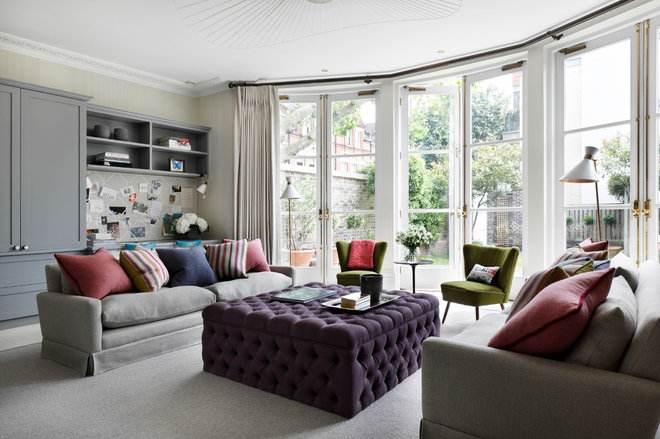 Turner Pocock
Turner Pocock
First, a bit of background
The new-traditional look originally stemmed from English country style, and featured saturated colours and multiple patterns teamed with heavy furniture and accessories. However, it has recently undergone a contemporary transformation and now encapsulates tufted-velvet furniture and jewel-toned colour schemes.
Today’s new-traditional look is one that can be incorporated on a large scale, or by simple accessories, into any home.
Natalie Fuglestveit Interior Design
Colour
New-traditional colours tend to moody, jewel-toned hues; think emerald green, claret red, burgundy, dark sapphire blue and saturated pinks – even mustard or sage green. These emerald-green cushions are a low-key nod to the new-traditionalist look.
How to work colour in on a smaller scale: Try picking out the nearest jewel-like colour in your current interior scheme, be it in an artwork, accessory or rug, then accentuate it by adding a throw, bedding or curtains in a similar (but stronger) or complementary colour.
Decorating with tertiary colours
On a larger scale: Consider purchasing, or reupholstering, one statement piece of furniture, such as a sofa, armchair or ottoman, in one of the aforementioned colours. This piece will immediately draw people’s attention, so be sure to place it in a room where it isn’t competing with other eye-catching accessories, arrangements, furniture or colours. This teal ottoman is a great example.
Tip: The rich colours common to new-traditional styling are a push back against the desaturated colour palettes that have been popular worldwide during recent times (think dusty pinks, minty greens etc). New-traditional style draws on bygone times where bright colours, comfort and cosiness were king.
Fabric
The fabric that is key to this latest interpretation of new-traditional style is velvet. This plush material is warm, cosy and perfect for bringing out the best in jewel tones and moody colours. However, it can attract hair – so be sure to keep any canine or feline friends away from it – or have a lint roller handy!
How to work fabric in on a smaller scale: Similar to the key colours; incorporate it on a small scale via curtains, a doona cover, lampshade or cushions.
Alexander James Interiors
Furniture
This look favours furniture in grand styles, such as Louis-shaped chairs, chesterfield-inspired sofas and chaise longues in clean, modern colours.
However, the new-traditional look also favours comfort, so don’t shy away from a cushy, well-padded sofa.
Tip: The new-traditional look takes inspiration from opulent, glamorous designs that haven’t been in the spotlight recently. Look to luxe hotels with tufted bedheads, Louis chairs and French provincial-inspired furniture for guidance. Bedheads are an especially opulent touch that are key to tackling this look on a large scale.
Carriage Lane Design-Build Inc.
How to work furniture in on a smaller scale: Try choosing one large or hero item as your statement piece, or introduce a square or round upholstered ottoman in velvet.
The key to this style is balance. It shouldn’t jar the eye or overshadow the rest of your decor.
5 techniques for getting scale right
Accessories
Accessories that go hand in hand with this look are based on a saturated warm colour palette, plush fabric and furniture. Try ceramics and glassware in dark, romantic colours and pair them with metallic ornaments and sculptural or romantic floral arrangements.
Charlotte Crosland Interiors
How to work accessories in on a smaller scale: Collections of shapely ceramics in dark colours grouped together in vignettes on shelves will set this look off well, especially when combined with a few jewel-toned velvet furnishings. Play with scale and add a tall coloured glass vase to smaller, portly ceramic vessels. Vintage books will complement this look too.
Ultimately, new-traditional style is a decorating technique that offers a creative outlet for those wanting to experiment with large shapes, opulent colours and luxe fabrics, and who might be feeling a little restricted by minimalist interior styles that draw upon Nordic, Japanese and Danish decorating.
While those looks are here to stay, new-traditional style invites you to be brave, bold and excited by a saturated colour palette.
Comments (0)
17 May 2017
By portermathewsblog
Maggie Winterfeldt via domain.com.au
You’ve put heart, soul and a lot of bucks into turning your house into a home. The last thing you want is for someone to break in and rob you. A home intruder is scary to even think about, but spending a few minutes of time recognising and fixing ways your home is vulnerable can pay off big down the road.
Here are nine ways you may be inadvertently making your home more attractive to thieves:
Rundown front door
 Are you inadvertently making your home more attractive to thieves? Photo: Sean Locke
Are you inadvertently making your home more attractive to thieves? Photo: Sean Locke
Your front door is the first place burglars will look, and a dilapidated front door signals that your home is an easy target. A clean, painted front door gives the impression that the entire home is well-cared for and harder to breach.
Single lock
Burglars look to see what kind of locks they’ll have to navigate to enter, and when they see only the standard cylinder lock they’re more likely to have a go than if there’s also a padlock visible. In short: doubling up on locks makes your door physically more difficult to break into and your home less appealing to burglars.
Enticing trash
The discarded boxes and bags from all your big-ticket purchases are like advertisements to burglars of the valuables inside your home. Prevent thieves from getting as excited over your new flat screen TV box as you are with your new TV by keeping this type of garbage inside until trash pickup day.
Dark exteriors
Burglars don’t like to risk being seen, so when you create a barrier of light around your home using motion sensor activated and basic exterior lights, you’re creating a barrier around your home through which they’re not likely to penetrate. Pay special attention to vulnerable areas like front and back doors and walkways.
Welcoming landscaping
When planted beneath windows, bushes and shrubs are not only pretty, but they’re an obstacle to climbing into windows. Burglars are especially deterred by the kind of greenery that has thorns or makes loud snapping noises. For trees reaching up to second story windows, be sure to clean up lower branches so they can’t function as a ladder.
Overflowing mailbox
Piles of mail are a sign that you’re out of town and primed for a robbery. If you’re going away for a while, use the Request Hold Mail service to stop delivery while you’re gone. For shorter periods, a neighbour will likely be glad to pick up your deliveries.
Visible interiors
You don’t want burglars to get a peek at all the goodies you have inside your home, so shut the curtains, pull the shades, put a giant house plant in front of a street-facing window – do whatever you have to do to keep unwanted eyes out. Be especially mindful at night when the dark sky and lit interior combine to create a fishbowl effect in your home.
Empty house
Encountering the resident is way more than most burglars are bargaining for. If they think you’re in the house, they’re staying out of it, so make it look like someone’s home by turning on a light or two and even leaving on a TV or radio to make some noise. For prolonged periods away, you can use electronic timers to turn them on and off automatically.
Non-existent alarm system
They take a bit of financial investment, but a quality alarm system is a huge burglar deterrent, and a necessary one if you live in a high-crime neighbourhood. Do your research and pick a reputable alarm company – thieves know the bad and bogus alarm system signs – and consider high-tech options, such as alarms with a camera that allow you to monitor your home from anywhere.
Comments (0)
11 May 2017
By portermathewsblog
Author: Jen Dalley via domain.com.au

The next time you hear the rhythm of rain as it drums overhead, grab your boots and venture outside to follow the rainwater’s journey. After it hits your roof, where does it go to next?
If your home is like most, the water probably travels down gutters, through downspouts and onto an asphalt driveway, picking up traces of pollutants such as petroleum and pesticides along the way. Down a street gutter it goes, eventually finding its way into a storm drain. This may be as far as you can visibly follow the journey, but it certainly doesn’t stop there. Much stormwater runoff finds its way into nearby rivers and lakes.

Photo by Kettelkamp & Kettelkamp
Redirecting stormwater into the ground is a much greener option. Microorganisms in the soil are able to digest the pollutants, purifying the water on its path back into the aquifer. Allowing the water to seep into the ground also helps prevent the erosion of nearby waterways caused by runoff.
By replacing your impervious asphalt or concrete driveway with a permeable surface, you’ll be supporting groundwater recharge while also visually softening your property.
The first step in installing a permeable driveway (sometimes referred to as a sustainable drainage system, or SuDS) is deciding which design will work best for you.
Open-cell pavers are simply concrete pavers with holes that can be filled with a pervious material. Filling the cells with vegetation can soften the entire look and add a bit of green to your site.
The open-cell pavers shown here provide the minimum surface area a car would need to navigate the path.
What’s underneath the pavers is what really counts. A solid base is key to minimizing heaving and cracking. You will need a 15cm subbase of 3.8cm clean rock topped with a 10.1cm base of 1.9cm clean rock, to make the driveway stable enough for cars to pass over it. The paver system goes on top of that. A polyurethane liner should be used near any foundation walls or concrete that needs to be protected from water flow-back.

Photo by Shouldice Media
Pervious pavers commonly have joints filled with aggregate to allow water to penetrate between the pavers. Tabs are formed into each paver, providing the correct joint width and making installation easier. As with open-cell pavers, a sturdy base is required.
Some ceramic pavers are actually porous themselves, allowing the water to pass through the surface directly, instead of through the gaps between. This means the gap can be narrower and doesn’t have to be refilled with aggregate as often — a common chore with other pervious paver systems.
Due to the small size of the pavers, cracking or heaving is not an issue in cold climates.
Gravel is another surface to consider. It will also need a base underlayment to maximise its pervious nature. Usually this is a plastic mat made up of circular or honeycomb cells structured to provide load-bearing support. These cells are filled with gravel and help keep rainwater in the soil and out of sewers.

By Jen Dalley | Salt Lake City
A combination of systems can be used, too. Pavers and concrete strips together give this driveway visual interest.
When you have decided on a system and are ready to install it, look to redirect as much of the water as possible from your patio, roofline and downspouts to the new permeable area, so you’re capturing as much runoff water as possible.
Systems like this open cell with vegetation allow water to pass through as much as 40 per cent of the surface area.
Most jurisdictions enforce land-use codes that limit the buildable area on a lot. Many also include a maximum amount of impervious surface area allowed on a parcel. The driveway is a great place to include more permeable area, especially if the lot is small.

Photo by PLACE architect ltd. – Browse for a landscape designer
Interested in adding a permeable driveway? Here’s more info:
Who to hire: You’ll need an excavator to dig a trench for the system and a landscape crew to put in the paver system — especially if you use concrete and don’t want to mix and place the concrete yourself.
Considerations: Find out what type of soil you have. It could range from sand (fast drainage time) to clay (longer drainage time).
Permit: Check with your local council.
Best time to do this project: Late spring or summer, when the weather will cooperate. Construction during winter in colder climates is not recommended due to frost-depth issues.
Project length: One to two weeks.
Cost: Many permeable pavers within Australia allow you to request a sample size of the paver before purchasing, although the final cost will be affected by the type of paver, your location, the size of the project and the amount of site work required.
By installing a permeable driveway, you’ll be directly protecting the integrity of our natural resources, supporting groundwater recharge and adding green space to help balance carbon dioxide levels.
Comments (0)
10 May 2017
By portermathewsblog
via reiwa.com.au
 Perth’s property market continues to encourage first home buyers, with the latest preliminary data for the March quarter 2017 revealing the bulk of transactions occurred within the $400,000 to $450,000 price range.
Perth’s property market continues to encourage first home buyers, with the latest preliminary data for the March quarter 2017 revealing the bulk of transactions occurred within the $400,000 to $450,000 price range.
REIWA President Hayden Groves said market conditions in the March quarter highlighted that housing affordability remains an east coast issue.
“While the dream of home ownership is becoming increasingly difficult in some parts of Australia, particularly in Sydney and Melbourne, this isn’t the case in Perth.
“First home buyers remain active and continue to take advantage of improved affordability and choice in the market to secure a property that meets their needs. These factors, combined with record low interest rates, makes for positive buying conditions for those looking for a first home,” Mr Groves said.
Median house and unit price
Perth’s median house price slipped back over the quarter, with the preliminary median coming in at $505,000 for the three months to March 2017.
“This softening in median price is due to the ongoing trend of comparatively more transactions occurring in the lower end of the market, with fewer sales of properties in the $700,000 to $1.5 million price range. However, once all transactions have been accounted for, it’s likely the median will lift to around $517,000, just shy of December’s quarterly median,” Mr Groves said.
Perth’s preliminary median unit price held up reasonably well over the quarter, coming in at $411,750 for the three months to March 2017.
“In the unit market, although there were more transactions occurring in the $350,000 to $450,000 price range, early indications suggest there was also a boost in volumes between $600,000 and $1 million, which has kept the unit median strong over the quarter,” Mr Groves said.
Sales activity
The preliminary total dwelling sales figure for WA came in at 6,496 for the three months to March 2017.
Mr Groves said this figure was below the revised December quarter 2016 sales figure, which wasn’t unusual.
“Although preliminary total WA dwelling sales figures are down compared to the December quarter, once all transactions for the March quarter have been recorded, we expect this figure to lift to approximately 8,500, putting this quarter’s activity levels on par with the December 2016 quarterly figures.
“Additionally, early indicators suggest a rebound in house sales in the Perth metro area for the March quarter, with transactions expected to lift to around 6,500. This would put house sales volumes in the Perth metro region for the March quarter up significantly higher than the December quarter 2016 and marginally above the same time last year.
“These stable, moderately improving market conditions provide for equitable buying and selling conditions for both buyers and sellers,” Mr Groves said.
Listings for sale
Listings for sale in Perth increased over the quarter, sitting at 14,845 at the end of March 2017.
“It’s common for listings to rebound in the March quarter following the seasonal dip in listings over the festive period. This quarter’s listings figure is similar to levels experienced in the latter half of last year.
“Stock levels have been well controlled with total listings having declined by 2.7 per cent compared to the March quarter 2016,” Mr Groves said.
Average selling days and discounting
On average, it took vendors 70 days to sell their property in the March quarter.
Mr Groves said the proportion of vendors needing to discount their asking price held steady over the quarter at 55 per cent.
“We’ve also seen an improvement in the amount vendors are having to discount by, with figures revealing the average discount had fallen to 6.4 per cent in the March quarter, from seven per cent in the December quarter 2016,” Mr Groves said.
Comments (0)
04 May 2017
By portermathewsblog
With an increasing number of lifestyle movements like hygge advocating the joys of a cosier, more laid-back way of life, we’re spending more and more time in the comfort of our homes. Staying in is made all the sweeter however, when you’ve got creature comforts to indulge in, one of which is a reading nook.
Every bibliophile knows there’s no greater joy than a calm, quiet space where they can fully escape with a book in hand. And the good news is, you don’t need to have oodles of in-house space to make it a reading nook a reality. We spoke to Chris Carroll, editor and interior stylist of The Life Creative, to get the (very easy) how-to.
1. Make the Most of Your Living Room
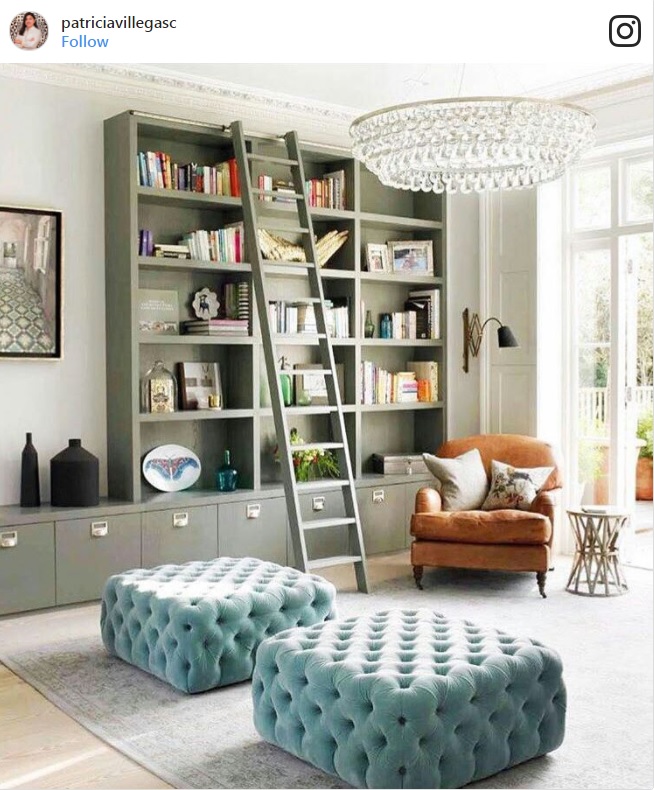
Image Source: POPSUGAR Photography / Maria del Rio
You don’t always need to have a dedicated corner in the house or home office to make a reading nook work. According to Chris, the living room is a growing increasingly popular as the space of choice. “Especially if you’ve got one of those L-shaped sofas, putting an armchair diagonally across from that L-shape will make the room feel quite resolved,” he says. “A living room like that is a really good example where it’ll not only function well because you can sit and get cosy, but visually, it makes the room make more sense because it’s quite balanced in terms of the furniture in the space.”
2. Grab a Chair (a Very Comfy Chair)

Image Source: POPSUGAR Photography / Maria del Rio
For reading nooks, the best kinds of chairs are literally, the kind you would never want to leave. Ones with nice upholstery work best, and avoid hard woods or leathers. “Look for chairs that have a high back — a wing back is a really good example of a particular type of armchair you’d want to cosy up in,” says Chris. “There are a lot chairs on the market that don’t have arms on them, I’d avoid those — you want something that’s going to hug and hold onto you, and that you can sink into as well.”
3. Opt For a Small Side Table
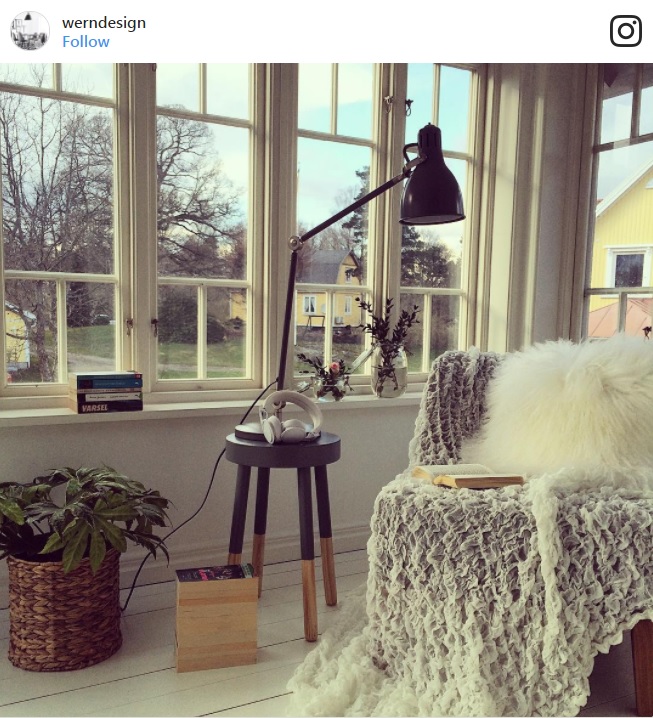 Image Source: POPSUGAR Photography / Maria del Rio
Image Source: POPSUGAR Photography / Maria del Rio
“I always recommend going for a round side table — something to put a drink on, or your books or glasses. If you have it on tripod legs or similar , it gives the illusion of more legs and air flows through, so it makes it feel a little bit fresher,” says Chris.
4. Pick the Right Lighting
 Image Source: POPSUGAR Photography / Maria del Rio
Image Source: POPSUGAR Photography / Maria del Rio
Nothing’s worse than getting to the end of a thrilling chapter and realising you’ve been squinting your through it, so having the right lighting is key. “To nicely light up the space, I’d gravitate towards floor lamps that have a directional head of them you can point toward you.,” says Chris. “Avoid things like lamp shades because they don’t actually cast enough light down onto the nook itself.”
This is all about amping up the cosiness factor. “Putting on some throws, chunky knits, faux furs — adding some different textures and softness to the armchair,” Chris says.
Comments (0)
03 May 2017
By portermathewsblog
Christina Zhou via domain.com.au
- Worst house on the best street taking up the best spot
- Buying the best or worst house on a block
- Off-the-plan buyers seeing losses and lacklustre growth
Buying the worst house on the best street is a classic real estate adage, but it could be among the worst investment advice for those who don’t do their due diligence.
Crumbling houses being marketed as a “renovator’s delight” or a “blank canvas” may appear to be a bargain or an entry in to the area, but it might also require a buyer with deep pockets to do a thorough update.
Wakelin Property Advisory Richard Wakelin said buyers who purchase the worst house on the best street might need to spend a lot of money on rewiring, restumping, re-roofing or re-plumbling. The property might have “hidden costs” and also unfixable issues such as backing onto apartments or light industrial-type property, he said.
 Tax depreciation and stamp duty concessions should not be the main considerations for buying an investment. Photo: Jessica Shapiro
Tax depreciation and stamp duty concessions should not be the main considerations for buying an investment. Photo: Jessica Shapiro
“It definitely falls into the lure of a renovator’s delight, and most people get badly caught out by what they have to do to get the foundations of the actual building right,” Mr Wakelin said.
Some property advisers point to seemingly attractive tax advantages and stamp duty concessions that come with buying off-the-plan, but buyers who overlook other fundamentals could find themselves stumbling into an investment pit hole.
Investor Neda Tesic, 32, was encourage by her ex-partner and a former financial advisor to buy an off-the-plan two-bedroom apartment in Maidstone, about eight kilometres west of Melbourne’s CBD.
 High rental yields could mask the property’s scarcity value. Photo: Peter Riches
High rental yields could mask the property’s scarcity value. Photo: Peter Riches
She sold the property in 2015 for less than what she bought it for in 2008, during which house prices in the suburb took off.
“[They] talked about depreciation and I just took it for what it was, not realising the full story; in terms of how inflated it would be,” said Ms Tesic, who works in sales for an accounting software company. “It was so hard to get tenants in there as well because there were so many other apartments in the area.
“It was a very expensive lesson,” Ms Tesic said, adding that she would now take more time to research and look at comparable sales in the area.
 Experts say time in the market is key. Photo: Simon Bosch
Experts say time in the market is key. Photo: Simon Bosch
Mr Wakelin said many poorly performing properties were marketed with tax advantages as their main selling point.
Tax attractions such as gearing strategies, depreciation allowances and stamp duty savings might assist the financing of an investment in early years, he added, but they should not be the primary reason to invest, because too often they mask the property’s scarcity value and propensity for capital growth.
While some investors try to time the market, many property experts argue it is better to buy when you can afford it.
“Time in the market” rather than “market timing” was the key, but investors needed to do their research very thoroughly, Mr Wakelin said. “Procrastination is the greatest thief of time.”
An investment offering high rental yields could also raise a red flag.
Allen Wargent Property Buyers principal Pete Wargent said the worst investments over the past decade in Australia had been those where people had focused on the rental yields to the exclusion of almost everything else.
Though mining towns offered rental yields of 15 per cent or more during the mining boom until 2012, it reflected the risk in the asset, he said.
“A lot of people have been badly hurt, particularly since 2012, and I think some of the high-profile locations that have been hit have been small mining towns, but even in some larger areas like Gladstone have had some severe corrections.
“That’s probably been the worst advice in Australia over the last 10 years.”
Sydney buyers’ agent Victor Kumar, director of Right Property Group, said one of his bad investments was a serviced apartment he bought in 2009, with the intention of hosting friends and family and using it as a holiday pad.
Though the gross rent could look really attractive, a lot it goes into the letting fee and running costs, Mr Kumar said, adding that serviced apartments were also very seasonal.
Comments (0)